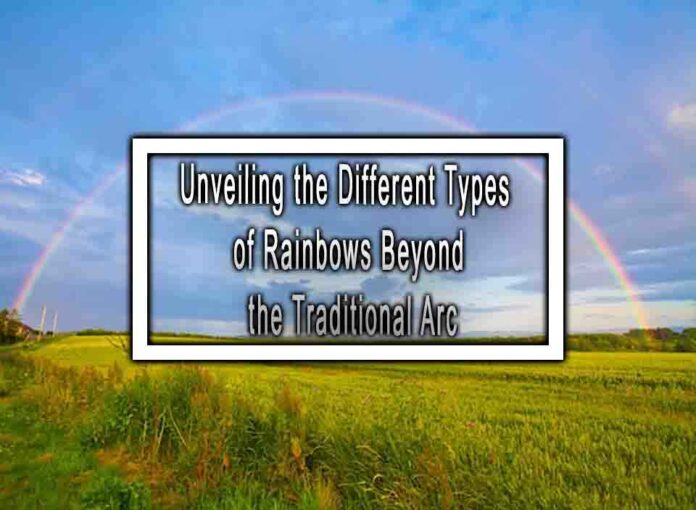Rainbows are captivating meteorological phenomena that appear when sunlight is refracted, reflected, and dispersed by raindrops in the atmosphere. While the traditional rainbow is a semicircular arc of colors, there are various other types and related optical effects. Here are some of the different types of rainbows and related phenomena:
Primary Rainbow (Traditional Rainbow):
- The primary rainbow is the most common type and consists of a semicircular arc of colors with red on the outer edge and violet on the inner edge. It forms when sunlight is refracted, reflected internally, and refracted again as it passes through raindrops.

Secondary Rainbow:
- The secondary rainbow is fainter and appears outside the primary rainbow. Its colors are reversed, with violet on the outer edge and red on the inner edge. This rainbow results from two internal reflections within raindrops and is usually less vivid than the primary rainbow.
Supernumerary Rainbows:
- Supernumerary rainbows are faint, closely spaced bands of color that appear on the inner edge of the primary rainbow. They result from interference patterns caused by the varying thickness of raindrop layers.
Double Rainbow:
- A double rainbow consists of both a primary and a secondary rainbow. The secondary rainbow is situated outside the primary rainbow. Double rainbows are relatively rare and occur when sunlight undergoes multiple internal reflections within raindrops.
Higher-Order Rainbows:
- Higher-order rainbows are fainter and rarer than primary and secondary rainbows. They result from multiple internal reflections and can appear as third-order, fourth-order, or higher-order rainbows. These rainbows have more faintly colored bands.
Twinned Rainbow:
- A twinned rainbow occurs when two rainbows appear to intersect or touch at a point. This is a relatively rare phenomenon and is often associated with sunlight passing through hexagonal ice crystals rather than raindrops.
Circular Rainbow (Full Circle Rainbow):
- While traditional rainbows form a semicircular arc, circular rainbows are complete circles with their center below the horizon. They are extremely rare and typically observed from high vantage points, like mountains.
Fogbows (White Rainbows):
- Fogbows are similar to rainbows but appear in foggy or misty conditions. They lack the vibrant colors of rainbows and often appear as white or pale arcs. They are formed by smaller water droplets that diffract light rather than refracting and reflecting it.
Glories:
- Glories are colorful rings that appear around the shadow of an object, like an aircraft or mountain peak, when it is surrounded by mist or clouds. They are often seen in combination with a fogbow.
Brocken Spectre:
- A Brocken Spectre is a complex optical effect that occurs when a person’s shadow is cast onto a cloud or mist, creating a halo or ring of light around the shadow. This phenomenon is often associated with mountain landscapes.
Each type of rainbow or related phenomenon is a result of the intricate interaction between sunlight and atmospheric conditions. While primary and secondary rainbows are the most commonly observed, the others are more rare and may require specific atmospheric conditions to occur.











